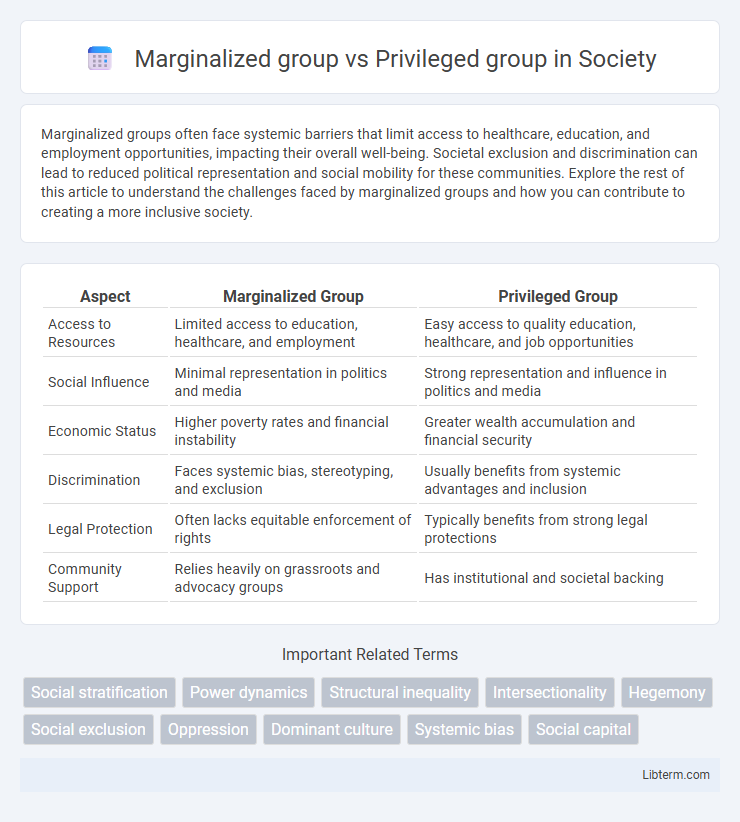Marginalized groups often face systemic barriers that limit access to healthcare, education, and employment opportunities, impacting their overall well-being. Societal exclusion and discrimination can lead to reduced political representation and social mobility for these communities. Explore the rest of this article to understand the challenges faced by marginalized groups and how you can contribute to creating a more inclusive society.
Table of Comparison
| Aspect | Marginalized Group | Privileged Group |
|---|---|---|
| Access to Resources | Limited access to education, healthcare, and employment | Easy access to quality education, healthcare, and job opportunities |
| Social Influence | Minimal representation in politics and media | Strong representation and influence in politics and media |
| Economic Status | Higher poverty rates and financial instability | Greater wealth accumulation and financial security |
| Discrimination | Faces systemic bias, stereotyping, and exclusion | Usually benefits from systemic advantages and inclusion |
| Legal Protection | Often lacks equitable enforcement of rights | Typically benefits from strong legal protections |
| Community Support | Relies heavily on grassroots and advocacy groups | Has institutional and societal backing |
Defining Marginalized and Privileged Groups
Marginalized groups consist of individuals who experience systemic discrimination, social exclusion, and limited access to resources and opportunities based on characteristics such as race, ethnicity, gender, sexual orientation, or socioeconomic status. Privileged groups hold disproportionate power, advantages, and access to resources, often benefiting from social, economic, and institutional structures that maintain their dominant status. Understanding these dynamics is essential for addressing inequalities and promoting social justice through equitable policies and representation.
Historical Contexts of Power and Inequality
Marginalized groups have historically experienced systemic exclusion and discrimination through laws, social norms, and economic policies designed to maintain unequal power dynamics favoring privileged groups. Privileged groups benefit from sustained access to resources, political influence, and cultural dominance that reinforce their societal advantages across generations. This historical context of power and inequality shapes ongoing disparities in education, employment, legal representation, and healthcare outcomes.
Social Identity and Group Membership
Marginalized groups often experience social exclusion and limited access to resources due to their social identity markers such as race, gender, or socioeconomic status, which shapes their group membership dynamics. In contrast, privileged groups benefit from systemic advantages and institutional power that reinforce their dominant status and social capital. Understanding the intersectionality of social identities within these groups reveals how power structures maintain inequality and influence individual and collective experiences.
Manifestations of Privilege in Daily Life
Privilege manifests in daily life through unequal access to resources such as quality education, healthcare, and employment opportunities that reinforce systemic advantages for privileged groups. Social norms often favor those with privilege by granting them automatic credibility, freedom of movement, and protection from discrimination or microaggressions. This embedded societal bias perpetuates disparities, limiting marginalized groups' social mobility and access to power structures.
Barriers Faced by Marginalized Communities
Marginalized groups encounter systemic barriers such as limited access to quality education, healthcare disparities, and employment discrimination that hinder socioeconomic advancement. Social exclusion and lack of political representation further entrench inequalities, reducing opportunities for civic participation and resource allocation. These structural impediments perpetuate cycles of poverty and social disadvantage, reinforcing the gap between marginalized communities and privileged groups.
Intersectionality: Layers of Privilege and Marginalization
Intersectionality reveals how individuals can experience overlapping layers of privilege and marginalization based on race, gender, class, sexuality, and other social identities. A person may belong to a privileged group in one context while facing marginalization in another, highlighting complex social dynamics that influence access to resources and opportunities. Understanding these intersecting identities is crucial for addressing systemic inequality and fostering inclusive policies.
Representation and Voice in Media and Society
Marginalized groups consistently face underrepresentation and misrepresentation in media, resulting in limited visibility and distorted narratives that reinforce social inequities. Privileged groups often dominate media production and storytelling, shaping cultural norms and public discourse to reflect their perspectives and interests. Equitable representation and inclusive platforms are essential to amplify marginalized voices, fostering social awareness and promoting justice in society.
Systemic Discrimination and Institutional Bias
Systemic discrimination perpetuates disparities by embedding prejudiced policies and practices within institutions, disproportionately harming marginalized groups. Institutional bias reinforces unequal access to resources, education, and employment, favoring privileged groups and sustaining social hierarchies. Addressing these structural inequities requires critical examination of laws, organizational procedures, and cultural norms to dismantle barriers faced by marginalized communities.
Allyship and Advocacy for Equity
Allyship involves individuals from privileged groups actively supporting marginalized communities by amplifying their voices and addressing systemic inequities. Advocacy for equity requires sustained efforts to dismantle structural barriers and promote fair access to resources, opportunities, and rights for marginalized groups. Effective allyship and advocacy prioritize listening, education, and accountability to create inclusive environments and foster social justice.
Strategies for Building Inclusive Communities
Building inclusive communities requires implementing strategies such as equitable resource distribution, amplifying marginalized group voices, and fostering cultural competence among privileged groups. Creating safe spaces for dialogue encourages understanding and reduces systemic barriers that perpetuate exclusion. Prioritizing policies that promote accessibility, representation, and anti-discrimination ensures long-term social equity and community cohesion.
Marginalized group Infographic

 libterm.com
libterm.com